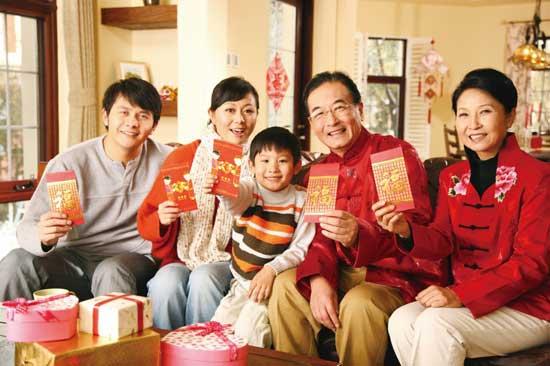If you visited China or have Chinese friends, you may wonder why Red is so popular in China and Chinese daily life? it is a broad topic, and a tradition lasted probably for thousands of years, and flows in every Chinese's vein. In the previous blog, we discussed briefly about the origin of red color adoration and some of its politic meanings, and in this blog, we are going to explore as many culture as we could related to Chinese's red adoration.
Similar to Dragons, which was, and still is, symbolized as evil, violate and power in western cultures. Such as the dragons in Game of Throne.
 |
| Khaleesi and the badass dragon |
Although their terrifying look is somehow mitigated by the blond beauty sitting nearby, the diabolical faces is still....ehh... ferocious, and always claiming "I WILL EAT YOU ALIVE!!!!"
Now, compare to this,
 |
| Modern redesign of pre-historical Chinese Dragon symbol |
or this,
 |
Lovely? I mean the dragon on her dress.
Fan Bingbing in a Dragon Dress
|
All I wanted to say is, red means something different and special in Chinese's culture. You may also notice that the color combination in those two images above, red and yellow. By the way, you guys prefer pink or green? I presume.
OK, enough chitchat, let's back to track.
As being said, red was not always the Chinese national color until the middle of 20th Century. However, it is believed that red was popular in civil life in a long history and was
reflected in many aspects of ordinary peoples’ daily life. Although it is
deemed that red was worshiped in China in primitive ages, it was carried out
and evolved into more meaningful cultural phenomenon, thus the adoring red is
linked with Chinese social psychology, which can be categorized into two main
aspects:
1. To avoid or defend calamities and evil spirits,
this is deemed to be derived from using fire to retreat wild animal in old
times. Examples of this aspects are commonly seen in Chinese Spring Festivals (and other traditional occasions) decorations and activities, such as red spring
couplets, door guardian gods, red lantern, red fire crackers, red envelop
 |
| Spring festival couplets, A must do for every family before every Spring Festival |
 |
| Nice one, eh... Close Enough, The English Version of Chinese Spring Couplets |
 |
| Door Guardian Gods in China |
 |
| Red Lantern in China |
So, it is the tradition for Chinese to fire the firecrackers and fireworks during spring festival, especially New Year Night, in order to welcome a clean and prosper New Year. One of the extended form of this is, stores and other businesses always fire firecrackers and fireworks at the first opening day after New Year Holiday to get a cheerful beginning and a sign of good fortune. You can also see firecrackers and fireworks in other occasions, such as weddings, and in some places when a new relative come to visit (such as the son-in-law family come to visit the parents-in-law for the first time during Spring Festival) for the first time, or a new-born baby comes home etc...
However, the smoke and trash afterwards makes it against environmental protection regulations, especially in large cities (such as Beijing). Thus government nowadays only allow firecrackers and fireworks in certain areas for a certain period of time during Spring Festival.
 |
| Fire firecrackers and fireworks at the first opening day for business after New Year |
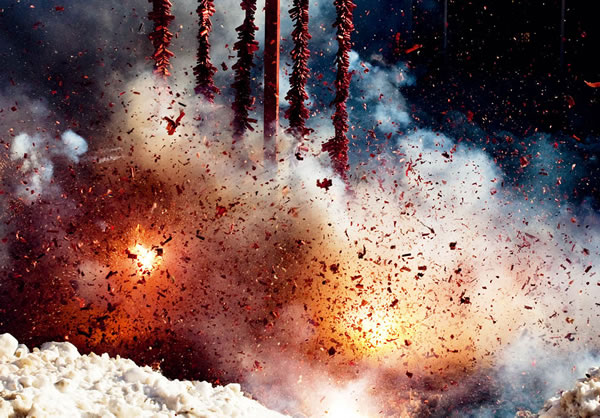 |
| Fire Crackers During Chinese Spring Festival |
The red envelops everybody loves. A red envelope, 红包 (Hong Bao) is a monetary gift given during holidays or special occasions such as weddings, the birth of a baby or graduation. During Spring Festival, it is given mostly to children and elders, and called as 压岁钱 [ia sui: tʃ an], the close translation is Lucky Money.
Side-talk: Origin of red envelope and Shou Sui (守祟or守岁 stay late in the Chinese New Year Night)
There was a minor monster called Sui(祟), it seeks and touches kids' forehead in the night of New Year, and that kid would go ill. In order to protect the kids, parents stay late in the night of New Year and leave the lights on in order to keep Sui out, and that is the origin of the Shou Sui (守祟, direct translation is Keep Sui Out).
One couple who had their son quite late in their age, and they loved him very much. So, like the other parents, they stayed late in their kid's bedroom, and got bored somehow deep in the night, then they started to play coin games. Suddenly, a wind blew in and killed the kindles, soon after that, they saw a shadow was approaching their kid's bed and that shadow reached its arm towards the kid. The parents were so scared and dropped the coins on the ground, and shouted and cried loudly, but didn't help much. In that very urgent moment, a sharp light beam shot out of the coins they played and hit the shadow monster, and defeated it. From then on, the parent spread the word about how the coins defeated the monster, and parents in every family from then on wrapped some coins with red papers and hide them under kids' pillar in Chinese New Year Night. And that is one version of the origin of Chinese Red Envelop.
In some places, people wear red underwear or
clothes, belt, personal ornament (such as bracelet) and sockets in the same
year as their born year’s zodiac. I am not going to post any image here, but you can try to search "中国红色内衣" (Chinese red underwear) in google image, then try "红肚兜" (it doesn't have a proper English name, something like belly band), it is the traditional female undergarment functioning similar to modern bra. Sure you will not be disappointed.
2. The second origin of red tradition is to worship life, especially fertility, examples are red everything in a Chinese traditional wedding, some food in occasions of new babies' born, elder's birthday etc.
The traditional Chinese Wedding is the place you probably will see a lot of red color. Among all of the items, the most popular symbols of Chinese Wedding are Red Double Happiness (below) and the pair of Dragon and Phoenix. The general procedure is, the bride is covered with red bridal veil, sits in a red sedan chamber (花轿,Flower Sedan Chamber) delivering her to her husband with a team of wedding music instrumental players (suona, drum) and dowry delivery, and then go through the wedding ceremony with her groom after arrival, bows to the parents etc., then after that she will sit on the red wedding bed quietly (or not) waiting for her groom to uncover her veil.
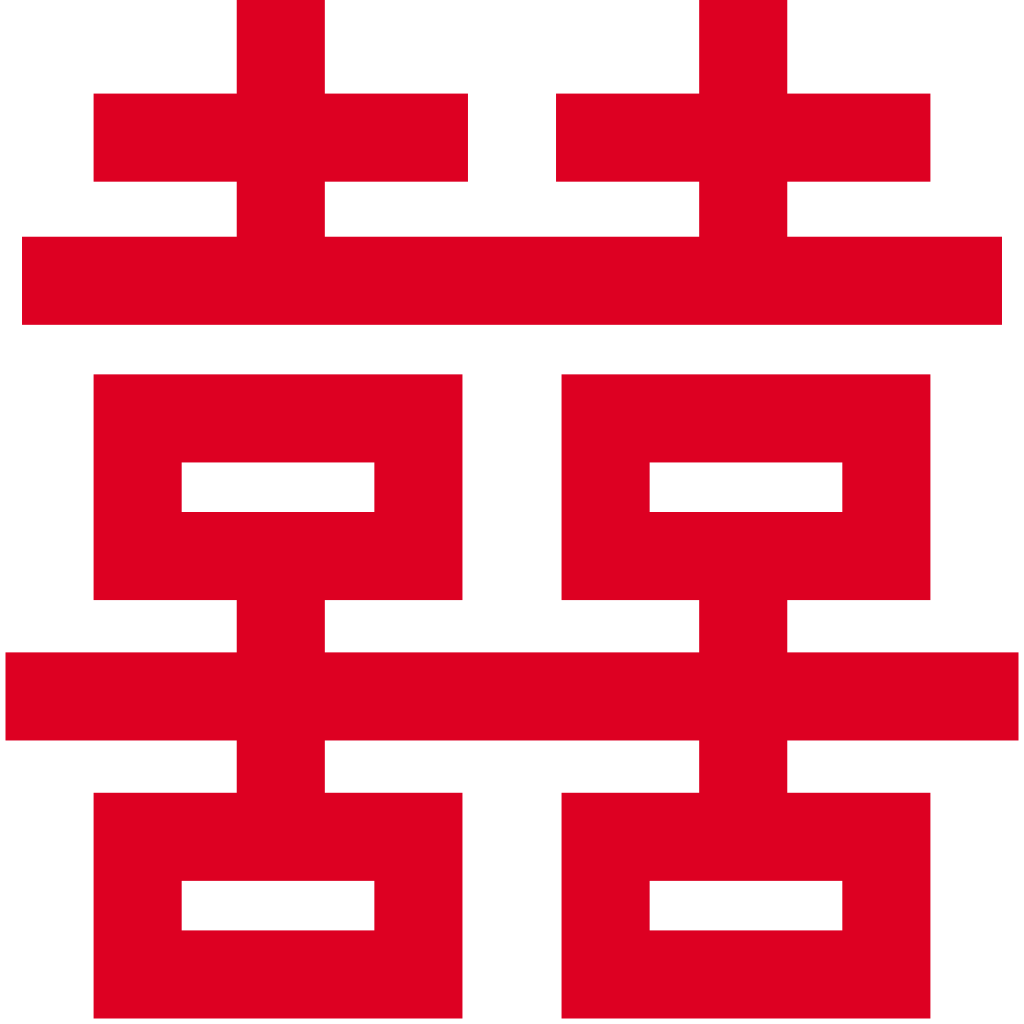 |
| 囍 xi (Happiness) |
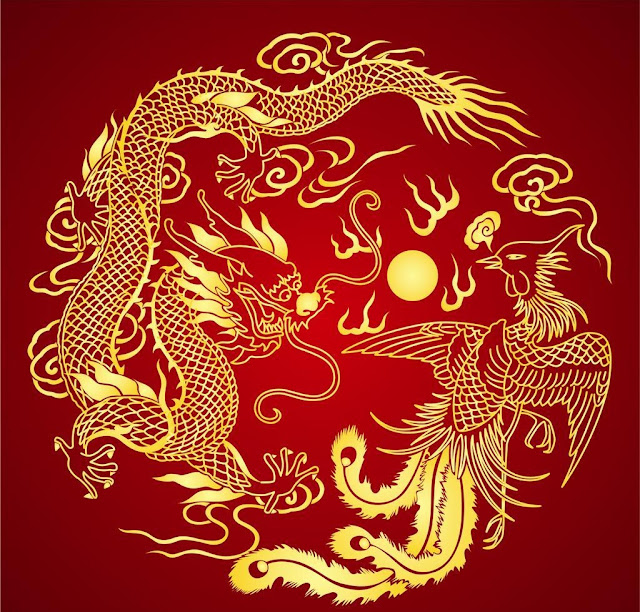 |
| Dragon and Phoenix in Chinese Traditional Wedding |
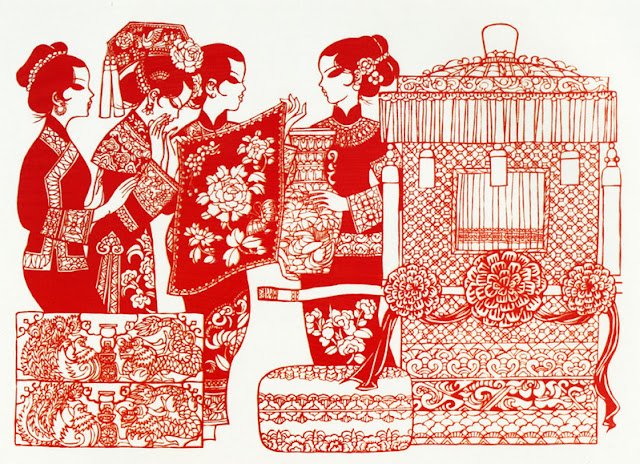 |
| Chinese Paper Art illustrating Traditional Chinese Wedding Procedures, 花轿 |
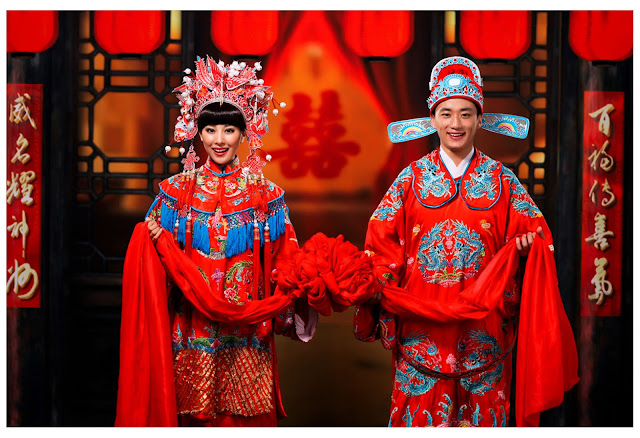 |
| Traditional Chinese Wedding Bride and Groom |
Birthday Clothes and Decoration. Especially it is for an elder, this clothe is the traditional uniform.
Those characters on the cloth are normally "福寿禄",福 means Happiness, 寿 for longevity, and 禄 for wealth.
 |
| Typical Decoration of Chinese Birthday for Elders |
 |
| Eat red egg at the first month ceremony of a new born baby in China |
Nowadays, many Chinese just like red color subconsciously in their clothes or decorations and many other aspects in their life. If you ask a random Chinese why he/she likes it, the answer maybe red means happiness or warmth or life etc., but whatever it is, as long as you like and it in return makes you happy, it is already good enough.
(All of the images are sourced from the internet, please contact me if there is a violation of the copyright.)
